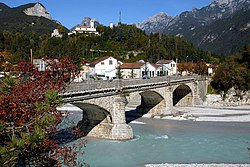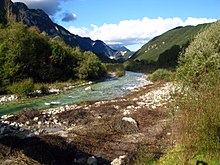| Moggio Udinese | ||
 | ||
| State | Italy | |
|---|---|---|
| Region | Friuli Venezia Giulia | |
| Territory | Tarvisian | |
| Altitude | 341 m a.s.l. | |
| Surface | 142.44 km² | |
| Inhabitants | 1.707 (2016) | |
| Name inhabitants | Moggesi | |
| Prefix tel | 39 0433 | |
| POSTAL CODE | 33015 | |
| Time zone | UTC 1 | |
| Patron | St. Gallen (March 19) | |
Position
| ||
| Institutional website | ||
Moggio Udinese (Mueç in Friulian, Mosach in German, Možac in Slovenian) is a center of the Friuli Venezia Giulia.
To know
Geographical notes
The town is surrounded by the high peaks of the Julian Alps and the Carnic Alps: to the south it dominates the Plauris group (1,958 m), to the west the limestone - dolomitic pyramid of Mount Amariana (1,906 m), to the north the Creta Grauzaria rises imposing (2,065 m) and the Zuc dal Bôr (2,195 m), while to the east there is the Canin group. It is 17 km from Tolmezzo, 20 from Gemona del Friuli, 26 from Pontebba.
Background
Archaeological and numismatic findings attest to the existence of a Roman lookout or castelliere, which dominated a large part of the Fella valley from the Santo Spirito hill.
In the 11th century, Count Cacellino, a Carinthian noble, Count Palatine and supreme master of the imperial court, owned vast territories in his homeland and in Friuli, including the castle of Moggio. Arranging to leave for the Holy Land in 1070 or 1072 according to legend, he would have left his possessions to his cousin Federico, patriarch of Aquileia, to build a Benedictine monastery on the site of the castle, which would enjoy the income and possessions of the castle. On 9 June 1119 the patriarch Voldaric I had the monastery of Moggio consecrated by Andrea Emona (bishop of Cittanova d'Istria). The monastery was named after St. Gallen, like the famous monastery in Switzerland of which the patriarch had been abbot. To increase the prestige of the new abbey, the patriarch granted it vast properties in Carinthia, in Friuli and in Carnia. He also granted supremacy over the parish churches of Cavazzo, Dignano and Gorto.
After the bull of Lucio III (1185) the Moggesi abbots were immediately subject only to the Holy See. The abbey was sacked by the German soldiers of Emperor Conrad IV. Ghiberto da Marano sul Panaro, contemporary and vicar general of the patriarch Bertrand of San Genesio, was its abbot from 1329 to 1349, the year in which he was assassinated. Parishes or cures depended on the abbot, over which he exercised his jurisdiction by means of parish priests, curates or chaplains, secular or regular, appointed by him; the administration took place by means of camerari, who were required to present themselves for the homage visit every year, on the solemnity of the consecration of the monastery or on that of the patron saint St. Gallen (October 16). Due to the temporal jurisdiction the abbot was the feudal lord of the patriarch of Aquileia and it had full and entire jurisdiction with mere and mixed empire including jus sanguinis and with many high prerogatives, over the entire Fella valley and over the villa of Baiuzzo in Friuli. He had the right to vote in the parliament of Friuli. Documents from the 13th and 14th centuries listed 146 landed possessions.
With the fifteenth century the jurisdiction and administration of the abbey were entrusted by the abbots, who became commendatories, to their vicars and procurators. In 1420 it passed into the territory of the Republic of Venice. San Carlo Borromeo was abbot of Moggio from 1561 to 1566
With the death of Count Felice Faustino Savorgnano (1773) the abbey church was converted to a simple parish church and the feudal jurisdiction was put up for auction and purchased for 44,000 ducats by the lords Mangilli and Leoni who assumed the title of Marquis of San Gallo. Only in 1869 did Pope Pius IX return the title of abbey church to the parish church of Moggio.
Bushel passed in 1815 with the Congress of Vienna under the dominion ofAustria. With the third war of independence (1866) it became part of the Kingdom of Italy.
During the First World War it was the seat of the military command of the Val Fella sector and of the detachment in Bevorchians. In 1917 the iron bridge over the Fella that connected Moggio to the state road was blown up by the Italian bomb squads on the occasion of the Caporetto route.
In 1976 the town suffered substantial damage from the earthquake of Friuli.
How to orient yourself
Neighborhoods
The town is divided into the two nuclei of Bushel of Below (341 m) and Bushel of Sopra (381 m).
Its municipal territory also includes the villages of Bevorchians, Campiolo, Dordolla, Grauzaria, Moggessa, Monticello, Ovedasso, Pradis-Chiaranda and Stavoli.
How to get
![]()
- 1 Friuli-Venezia Giulia Airport, via Aquileia 60 (in Ronchi dei Legionari), ☎ 39 0481 773224.
By car
How to get around
What see

- 1 Abbey of St. Gall (Bushel of Sopra). The Abbey of San Gallo is a monastery located on the hill of Santo Spirito. The Benedictine abbey was founded in 1085 by Frederick of Moravia, patriarch of Aquileia, but probably previously there was a Roman observation station, as can be deduced from a plaque that is walled into a column of the cloister. The abbey was consecrated by the patriarch Ulrich of Eppenstein in 1119 and was dependent on the Abbey of San Gallo in Switzerland. In a short time it acquired dominion over the whole valley. Furthermore, the abbots of Moggio had the right to vote in the Parliament of the Fatherland of Friuli and their disputes over border issues, first with the Counts of Gorizia and subsequently with the community of Venzone, also involved the dukes ofAustria. The abbey was suppressed in 1776.
- During the sixteenth century, St. Charles Borromeo was commendatory abbot. The ancient tower, which for centuries had been the seat of abbey judgments, was transformed into a prison in 1800.
- The abbey was partially destroyed by the 1976 Friuli earthquake, after being damaged by those of 1348 and 1511.
- Since 1985 it has been a cloistered female monastery of the Order of Santa Chiara.

- Palace of the Prisons. Ancient medieval tower of the Abbey of St. Gall, justice was administered there. In the nineteenth century it became a prison.
- 2 Julian Prealps Natural Park. The Julian Prealps Natural Park partly falls within the territory of Moggio, as well as other neighboring municipalities. Equipped with cycling, hiking and alpine routes, it allows total immersion in the rich nature of the Friulian Alps which offer a great diversity of tree and animal species.
- There are numerous alpine refuges in which to refresh oneself, stay overnight, and to be used as stops for multi-day mountain routes.
- The territory of the park, established in 1996, extends over 9,402.00 hectares between the pre-Alps and the Julian Alps. The main peaks are Monte Canin (2,587 m), Monte Plauris (1,958 m), the chain of Monti Musi (1,869 m).

- 3 Baths of Lusnizza. It is the fraction of the municipality that you meet when you go from Pontebba to Tarvisio and is made up of two villages separated by a meadow where the village church, dedicated to San Gottardo, stands. The locality is known for the source of sulphurous waters that flow from the Rio del Solfo, a few hundred meters east of the upper village.
- It had some notoriety in the past, but currently the thermal water is not exploited, even if projects for its use have been underway for decades.
Events and parties
What to do
Shopping
How to have fun
Where to eat
Average prices
- 1 [link not working]La Bruschetta Restaurant, Via Giorgio Ermolli, 6 (in Moggio di Sotto), ☎ 39 331 8047242.
- 2 [link not working]Agli Artisti restaurant, Office Square, 9, ☎ 39 335 7050534.
Where stay
Average prices
- 1 Residence Bed & Bike, Via Valsassina, 15 (in Moggio di Sotto), ☎ 39 347 2556958.
- 2 Locanda San Gallo, Piazzetta Sandro Pertini, 2, ☎ 39 0433 550318.
- 3 Leon Bianco Hotel Restaurant Bar, Office Square, 4, ☎ 39 0433 51114.
Safety
- 2 [link not working]St. Gallen Pharmacy, Via Giorgio Ermolli, 6 (in Moggio di Sotto), ☎ 39 331 804 7242.
How to keep in touch
- 3 Italian post, Piazzetta Sandro Pertini, 1 / A, ☎ 39 0433 50112.
Around
- Tolmezzo - In a wide valley in theFriulian Alpine Arch, the city is the most important center of Carnia and is therefore considered its de facto capital.
- Gemona del Friuli - The reconstruction of the city after the terrible 1976 earthquake that brought it to its knees is an unparalleled example of the value of its people who, in addition to the houses, have rebuilt, stone by stone, its beautiful Cathedral as it was.
Other projects
 Wikipedia contains an entry concerning Moggio Udinese
Wikipedia contains an entry concerning Moggio Udinese Commons contains images or other files on Moggio Udinese
Commons contains images or other files on Moggio Udinese

